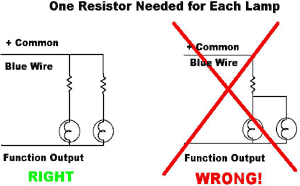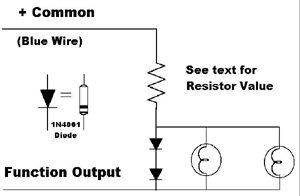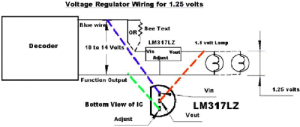Using Low Voltage Lamps with DCC Decoders
by Don Fiehmann
• Download in PDF format (55 kB)
• see also Installing LEDs with DCC Decoders
Thanks to Don Fiehman for drafting these handy tips for using LEDs and Low Voltage Lamps with DCC.
This series of tech notes is designed to help modelers with DCC decoder installation. Much of the information comes from questions asked by modelers and tips we have found. This note covers using 12 to 16 Volt lamps and the 1.5 Volt lamps with DCC decoders.
Low Voltage Lamps
Lamps convert the input power to heat and light. More of the power is used for heat than light. (LEDs do a better job of converting power to light.) When power is applied to a cold lamp the internal filament must be heated. Up to 10 times the operating current flows to heat the cold filament. This high inrush current is the reason that many lamps fail with first turned on. The high inrush current can exceed the ratings of most decoder function outputs. The transistors used in the decoders function output can stand a mild short overload. Too high an overload can damage these transistors. Adding a resistor to the lamp circuit can reduce the high inrush current to a save level. A resistor can also be used to reduce the voltage to match lamps at lower voltages.
12 to 16 Volt Lamps
The decoder’s function output voltage is typically a little less than the DCC track voltage. Most decoder have output ratings for the functions of 100 mA (milliamps) Lamps rated at 12 to 14 volts with current ratings less than 50 mA may be connected directly to the decoder. 12 to 14 Volt lamps with currents from 50 to 75 mA need a 22 ohm or 33 ohm 1/4 watt resistor in series with the lamp to protect the decoder from the high in-rush current when the lamp is first turned on. For currents from 75 to 100 mA use a 22ohm or 33 ohm 1/2 watt resistor. Lamp and resistor are wired from the common (blue wire) to the function output (white, yellow or other color function output wire).
1.5 Volt Lamps
Wiring two 1.5 Volt lamps in parallel is not a good idea. When one lamp burns out, the other lamp immediately becomes bright and burns out shortly after.
When using 1.5 Volt lamps the voltage must be reduced. There are a number of different ways to reduce the voltage from the decoder. This tech note will cover three different methods of voltage reduction.
1. Resistor
The simplest and cheapest way to reduce voltage is to use a resistor to drop the voltage. It is important to note that lamp current and track voltage vary with different manufacturers and scales. Changing any one of these variables, even slightly, will affect the lamps performance and could dim, suddenly burnout or never even turn on. The normal voltage of 14 Volts from the booster and some loss in wiring, rails and the decoder gives an output of about 13 to 13.5 Volts depending on load.
Use the following formula to determine the resistor value. Once the resistor value is computed you need to select a standard value resistor that is closest to the computed value. 15 mA current is equal to 0.015 A.
(Function Output Voltage - 1.5 (V)) / Lamp Current (A) = Resistor Value (Ohm)
(Function Output Voltage - 1.5 (V)) x Lamps Current (A) = Resistor wattage (W)
Sample calculation for a 1.5 Volt 15mA lamp
- (1) (Voltage 13 - 1.5) / Current 0.015 = 766.66 Ohm
- (2) Voltage x Current (13-1.5 ) X 0.015 = 0.1725 W
The closest standard value to this would be a 750 Ohm resistor at 1/4 (0.25) Watts.
In general resistors work but are not the best way to control low voltage to a lamp. There are better ways!
Alternate Circuits For 1.5 Volt Lamps
As pointed out in the previous page, lamps are sensitive to changes in current. Even individual lamp currents can very as much as 20%. Varying track voltage can also cause light intensity to change. Lamps need a constant voltage. A circuit that regulates the voltage can stabilize the changes in voltage and hold the light constant. The following two circuits regulate the voltage to the lamps.
2. Diode Regulator
This circuit uses two common 1N4001 diodes rather than resistors to regulate lamp voltage and has the advantage that more than one lamp can be connected to the same circuit (you will still need a separate circuit for each function output). Lamp brightness stays constant even when track voltage does not. It requires a few more parts but is trouble free and well worth the effort. The resistor should supply adequate current for the lamps used. Any excess current is bypassed to the diodes. Each diode has about a 0.7 Volt drop and the two produce about 1.4 Volts. Lamps can be wired in parallel with this circuit.
The following list of resistors is based on the maximum wattage of the resistors with 14 volts as the input to the decoder.
|
Resistor Value (Ohm)
|
Wattage (W)
|
Current supplied (mA)
|
Lamp(s)
|
|
560
|
0.25
|
20
|
One 15 mA
|
|
300
|
0.5
|
40
|
Two 15 mA or One 40 mA
|
|
150
|
1
|
80
|
Five 15 mA or Two 40 mA
|
3. IC Voltage Regulator
A very small IC voltage regulator can be used to power 1.5 Volt lamps. The output is 1.25 Volts which is ample for low current 1.5 Volt lamps and will increase the lamp's life. Of all of these circuits shown this one has the most stable output with varying voltages. The IC is an LM317LZ and is very small (TO-92). This is a common low cost IC and available at most electronic supply stores. The IC is rated at just over 1/2 Watt, will handle about 40 mA in this application without a resistor. For currents from 40 to 80 mA a resistor is needed to share the excess heat and prevent overheating the IC. (If overheated the IC will turn off to cool and then turn on.) The resistor value is not critical. The maximum current rating of the LM317LZ is 100 mA.
|
Resistor Value (Ohm)
|
Wattage (W)
|
Current supplied (mA)
|
Lamp(s)
|
|
none
|
0.25
|
up to 40
|
Two 15 mA
|
|
47 - 56
|
0.5
|
40 - 80
|
Five 15 mA or Two 40 mA
|
Lamps Available from Tony’s Train Exchange
Check out our discount prices for lamps on Tony’s website or call us at 1-800-978-3472.



